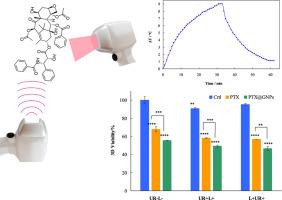Chemo-/sonodynamic/photothermal triune therapy in 2D and 3D models of MCF-7 cells using paclitaxel-loaded gold nanoparticles
IF 2.9
2区 生物学
Q2 BIOLOGY
引用次数: 0
Abstract
Objective
Breast cancer remains the most prevalent cancer among females globally, with an alarming rise in incidence. Conventional treatments like chemotherapy face several limitations, necessitating innovative approaches. In this study, the efficacy of a novel chemo-/sonodynamic/photothermal triune therapy utilizing paclitaxel-loaded gold nanoparticles (PTX@GNPs) for MCF-7 breast cancer cells treatment was explored.
Methods
PTX@GNPs were synthesized and characterized followed by measurements of 808-nm photothermal conversion efficiency and drug loading capacity. The combined dual therapies of chemotherapy/photothermal therapy (chemo/PTT), chemotherapy/sonodynamic therapy (chemo/SDT), and combined triune therapies of chemotherapy/sonodynamic therapy/photothermal therapy (chemo/SDPTT) and chemotherapy/photothermal therapy/sonodynamic therapy (chemo/PTSDT) of both 2D monolayer and 3D spheroid MCF-7 cells were evaluated using the MTT and resazurin assays, and reactive oxygen species detection. The impact of laser light and ultrasound radiations (light followed by ultrasound and vice versa radiations) was also investigated.
Results
PTX@GNPs exhibited a high loading capacity of 60 % and a photothermal conversion efficiency of 28.7 %. In the 2D culture model, chemo/SDPTT demonstrated superior cytotoxicity and ROS generation, compared to the monotherapies and other dual and triune therapies. In the 3D culture spheroids, while overall cytotoxicity was lower due to slower growth rates and limited oxygen diffusion, chemo/PTSDT again provided the highest efficacy.
Conclusion
The synchronized chemo/PTSDT modality employing PTX@GNPs exhibited significant synergistic effects against both 2D and 3D MCF-7 cell culture models. This approach outperformed free paclitaxel and monotherapies, emphasizing the potential of gold nanoparticles as an effective drug carrier and dual photo/sonosensitizer. Importance of treatment sequence during multimodal cancer therapies for better therapeutic outcomes was highlighted.

使用紫杉醇载金纳米颗粒在MCF-7细胞的2D和3D模型中进行化学/声动力/光热三位一体治疗
乳腺癌仍然是全球女性中最常见的癌症,其发病率呈惊人的上升趋势。像化疗这样的传统疗法面临着一些局限性,需要创新的方法。在这项研究中,研究了一种新的化学/声动力/光热三联疗法,利用紫杉醇负载的金纳米颗粒(PTX@GNPs)治疗MCF-7乳腺癌细胞的疗效。通过808 nm光热转换效率和载药量的测定,合成并表征了MethodsPTX@GNPs。采用MTT、reazurin测定和活性氧检测,对二维单层和三维球体MCF-7细胞进行化疗/光热联合治疗(化疗/PTT)、化疗/声动力联合治疗(化疗/SDT)、化疗/声动力联合治疗(化疗/SDPTT)和化疗/光热/声动力联合治疗(化疗/PTSDT)。还研究了激光和超声波辐射(光后是超声波,反之亦然)的影响。ResultsPTX@GNPs具有高达60%的负载能力和28.7%的光热转换效率。在2D培养模型中,与单一疗法和其他双重或三重疗法相比,化疗/SDPTT表现出更强的细胞毒性和ROS生成。在三维球体培养中,虽然由于生长速度较慢和氧气扩散有限,整体细胞毒性较低,但化疗/PTSDT再次提供了最高的效果。结论PTX@GNPs同步化疗/PTSDT模式对MCF-7细胞培养模型的2D和3D均有显著的协同效应。这种方法优于游离紫杉醇和单一疗法,强调了金纳米颗粒作为有效药物载体和双光/声敏剂的潜力。强调了在多模式癌症治疗中治疗顺序对更好的治疗效果的重要性。
本文章由计算机程序翻译,如有差异,请以英文原文为准。
求助全文
约1分钟内获得全文
求助全文
来源期刊

Journal of thermal biology
生物-动物学
CiteScore
5.30
自引率
7.40%
发文量
196
审稿时长
14.5 weeks
期刊介绍:
The Journal of Thermal Biology publishes articles that advance our knowledge on the ways and mechanisms through which temperature affects man and animals. This includes studies of their responses to these effects and on the ecological consequences. Directly relevant to this theme are:
• The mechanisms of thermal limitation, heat and cold injury, and the resistance of organisms to extremes of temperature
• The mechanisms involved in acclimation, acclimatization and evolutionary adaptation to temperature
• Mechanisms underlying the patterns of hibernation, torpor, dormancy, aestivation and diapause
• Effects of temperature on reproduction and development, growth, ageing and life-span
• Studies on modelling heat transfer between organisms and their environment
• The contributions of temperature to effects of climate change on animal species and man
• Studies of conservation biology and physiology related to temperature
• Behavioural and physiological regulation of body temperature including its pathophysiology and fever
• Medical applications of hypo- and hyperthermia
Article types:
• Original articles
• Review articles
 求助内容:
求助内容: 应助结果提醒方式:
应助结果提醒方式:


